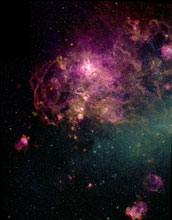Multimedia Gallery
30 Doradus, the Tarantula Nebula, in the Large Magellanic Cloud
30 Doradus, the Tarantula Nebula, in the Large Magellanic Cloud
This image of 30 Doradus--the Tarantula Nebula--in the Large Magellanic Cloud (LMC) was taken with the Curtis Schmidt telescope at Cerro Tololo Inter-American Observatory (CTIO) in Chile. It was taken as part of the Magellanic Cloud Emission Line Survey (MCELS) project.
More about this Image
The Tarantula Nebula is a giant star-forming region where energy from hot, young stars in the region creates dramatic voids and filaments in the surrounding gas. Located 160,000 light-years distant in the southern constellation Dorado, the LMC is considered the closest large galaxy to Earth.
Because of the proximity and low foreground absorption of the LMC, it is an ideal laboratory both for studies of individual HII regions, supernova remnants and superbubbles, and for investigations of global properties using samples of these objects.
MCELS is designed to provide uniform datasets in optical emission lines that are necessary to conduct this research. The MCELS observations toward the 30 Doradus region have been used to investigate the physical properties of the HII region, examine the physical conditions of supernova remnants in the field, and study the large-scale structure of the ionized gas.
This color image was produced using three separate exposures taken in hydrogen (red), sulfur (green) and oxygen (blue) filters.
Credit: Credit S. Points, C. Smith, R. Leiton, C. Aguilera and NOAO/AURA/NSF
Special Restrictions: Use of this image is restricted by the National Optical Astronomy Observatory (NOAO). For further information, see the NOAO/AURA Image Library's Conditions of Use Web page.
Images and other media in the National Science Foundation Multimedia Gallery are available for use in print and electronic material by NSF employees, members of the media, university staff, teachers and the general public. All media in the gallery are intended for personal, educational and nonprofit/non-commercial use only.
Images credited to the National Science Foundation, a federal agency, are in the public domain. The images were created by employees of the United States Government as part of their official duties or prepared by contractors as "works for hire" for NSF. You may freely use NSF-credited images and, at your discretion, credit NSF with a "Courtesy: National Science Foundation" notation.
Additional information about general usage can be found in Conditions.
Also Available:
Download the high-resolution TIF version of the image. (35.1 MB)
Use your mouse to right-click (Mac users may need to Ctrl-click) the link above and choose the option that will save the file or target to your computer.

